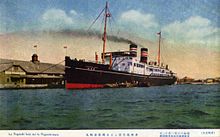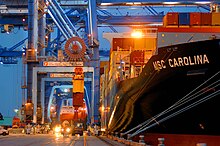30:
20:
286:
193:
instance, cooperation among many shipping lines in the industry is causing an anticompetitive market. This is one of the reasons for the high level of contestability in the shipping industry. With more cooperation among shipping lines, there are larger rates of ships and companies entering and leaving the industry. As of 2019, business and economic analysists are attempting to find solutions to reduce the
164:
for shipping lines. This means that the ease of entering and leaving the industry is high. The cause of this is due to the purchase of secondhand ships, the return on which can often be covered fairly quickly for commercial ships. Newer, expensive ships require a larger return on the investment but
76:
Oil became a crucial part of the shipping industry in the early 20th century. Its use varied from lubrication for developed machinery, burning in boilers and industrial plants, as well as for operating engines. Oil is also primarily shipped by specific shipping companies as opposed to other forms of
155:
Contemporary maritime transportation is bound by geographical constraints, political regulation, and commercial interests. Modern advances and innovations in shipping technology have grown the shipping industry since the twentieth century. Many of these advances include the size of vessels, the
192:
economy. While the maritime industry has always remained global by nature, shipping lines are now experiencing phenomenon that is unprecedented in scale or unseen at all before the 21st century. Many of these issues surround the nature of increased cooperation in the maritime industry. For
105:
Inland shipping along rivers and other freshwater bodies are used to transport cargo to ports other than those along the coast. Inland shipping requires more infrastructure than ocean shipping. Rivers and lakes require infrastructure, such as river ports and
110:, to be considered developed and ready for commercial use. Much of this infrastructure became more widely developed during the 19th and 20th centuries. Some principal waterways used by shipping lines in the 20th century were the
146:
operate shipping for approximately eight months each year, but cannot continue operations during winter months when the lakes typically freeze. Most inland shipping lines are based on speed and efficiency to deliver cargo.
172:
Innovations in the shipping industry are also being utilized by shipping lines to find solutions to global problems. For example, modern technology and research is being used to analyze the phenomenon of
91:
is the business of transporting people on shipping lines for the purposes of relocation or recreation. This became a growing industry near the turn of the twentieth century with the wide use of luxury
274:, or MARAD, was founded to regulate the merchant marine industry and fleet. However, a sharp rise in international ocean trade gave the two agencies expanded power in the growing maritime industry.
234:. Three major British shipping lines were founded in the 1830s: the British and American Steam Navigation Company, the Great Western Steamship Company and the Peninsular Steam Navigation Company.
185:. While part of this issue is due to human error as a result of lack of enforcement, advances in technology and ship design hope to improve the rates at which containers may be lost at sea.
254:
to protect
American shipping interests in response to changing foreign shipping policy. The responsibilities established under the Shipping Act were eventually transferred to the
246:
but before the nation officially entered the war, helped
American shipping lines during a period when commercial shipping grew under the demands of the war. Under this act, the
95:. Passenger cargo became a logistical challenge by attempting to balance pleasure voyage aspects with the structural limitations and requirements of the vessel.
420:
77:
transportation. This is considered a type of special cargo. The shipping of oil has become a debated issue due to the environmental impacts of both
419:
Frey, O. T., DeVogelaere, A. P. (2014, March). “The
Containerized Shipping Industry and the Phenomenon of Containers Lost at Sea”. Retrieved from
178:
142:. These waterways are still in use for commercial purposes today. Some waterways can only operate under seasonal conditions. For example, the
242:
The United States federal government passed the
Shipping Act of 1916 as a protection agency for American shipping. The act, passed during
270:
to regulate shipping activity in the United States, finally giving blanket authority to one shipping commission. At the same time, the
182:
271:
255:
421:
https://nmssanctuaries.blob.core.windows.net/sanctuaries-prod/media/archive/science/conservation/pdfs/lostcontainers.pdf
160:
and design, and automated ship systems. In terms of commercial interests, the maritime industry has a high level of
165:
pay off quickly. This is because these ships typically cater to a larger, more expensive crowd. For instance, new
468:
433:
177:
disappearing while at sea. These problems are being researched in part by government agencies, such as the
247:
513:
508:
263:
251:
194:
210:
Large-scale shipping lines became widespread in the nineteenth century, after the development of the
432:
Parthibaraj, Calwin S.; Subramanian, Nachiappan; Palaniappan, P.L.K.; Lai, Kee-hung (January 2018).
169:
can often be paid off within ten years due to the entrepreneurial nature of its intended purpose.
315:
300:
73:, refers to a wide assortment of goods that may be delivered to several ports around the world.
259:
29:
222:
took place and by 1833, shipping lines had begun to operate steamships between
Britain and
19:
250:
was also formed. In 1920, after the end of World War I, the federal government passed the
8:
56:
Shipping companies provide a method of distinguishing ships by different kinds of cargo:
399:
305:
174:
157:
390:
Davies, J. E. (1986). "Competition, Contestability and the Liner
Shipping Industry".
188:
Other challenges being pursued in the maritime industry include adaptation to a more
127:
448:
291:
70:
310:
267:
88:
489:“History of the Federal Maritime Commission”. (2019, March 11). Retrieved from
373:
223:
219:
161:
131:
452:
502:
215:
189:
98:
66:
63:
is a type of special cargo that is delivered and handled in large quantities.
218:
was the centre of development; in 1819, the first steamship crossing of the
285:
139:
115:
23:
490:
243:
166:
143:
119:
101:
is a term used for one specific product being shipped to a specific port.
92:
403:
135:
82:
60:
211:
78:
431:
46:
231:
156:
size of fleets, specialty purposes for ships within the fleet,
33:
Container ships are used by shipping lines to transport cargo.
227:
111:
107:
123:
50:
197:
and promote competitive growth in the maritime industry.
434:"Sustainable decision model for liner shipping industry"
49:
whose line of business is ownership and operation of
368:Rodrigue, J. P. (2017). “Maritime Transportation”.
281:
134:. Examples of waterway infrastructure include the
500:
179:National Oceanic and Atmospheric Administration
374:https://transportgeography.org/?page_id=1762
16:Business that transports cargo aboard ships
372:. New York, NY: Routledge. Retrieved from
392:Journal of Transport Economics and Policy
350:. New York, NY: D. Van Nostrand Company.
28:
18:
464:
462:
501:
491:https://www.fmc.gov/about/history.aspx
469:British History - Victorian Technology
389:
183:Monterey Bay National Marine Sanctuary
272:United States Maritime Administration
485:
483:
481:
479:
477:
459:
415:
413:
385:
383:
381:
364:
362:
360:
358:
356:
342:
340:
338:
336:
334:
332:
237:
441:Computers & Operations Research
205:
13:
370:The Geography of Transport Systems
150:
14:
525:
474:
410:
378:
353:
329:
24:Nippon Yusen Kaisha Shipping line
284:
260:President Franklin D. Roosevelt.
425:
1:
322:
248:United States Shipping Board
7:
277:
264:Federal Maritime Commission
10:
530:
200:
453:10.1016/j.cor.2015.12.005
268:President John F. Kennedy
195:anticompetitive practices
266:was created in 1961 by
316:World Shipping Council
301:List of ship companies
256:Department of Commerce
34:
26:
346:Hardy, A. C. (1928).
181:that operates in the
32:
22:
348:Seaways and Seatrade
226:possessions such as
252:Merchant Marine Act
214:in 1783. At first,
175:shipping containers
514:Shipping companies
509:Maritime transport
306:Maritime transport
158:naval architecture
35:
27:
238:American shipping
128:Mississippi River
521:
493:
487:
472:
466:
457:
456:
438:
429:
423:
417:
408:
407:
387:
376:
366:
351:
344:
294:
292:Transport portal
289:
288:
206:British shipping
71:break-bulk cargo
43:shipping company
529:
528:
524:
523:
522:
520:
519:
518:
499:
498:
497:
496:
488:
475:
467:
460:
436:
430:
426:
418:
411:
388:
379:
367:
354:
345:
330:
325:
320:
311:Shipping portal
290:
283:
280:
240:
208:
203:
153:
151:Modern shipping
89:Passenger cargo
69:, now known as
17:
12:
11:
5:
527:
517:
516:
511:
495:
494:
473:
458:
424:
409:
398:(3): 299–312.
377:
352:
327:
326:
324:
321:
319:
318:
313:
308:
303:
297:
296:
295:
279:
276:
239:
236:
224:British Empire
220:Atlantic Ocean
207:
204:
202:
199:
162:contestability
152:
149:
132:Columbia River
103:
102:
96:
86:
74:
64:
15:
9:
6:
4:
3:
2:
526:
515:
512:
510:
507:
506:
504:
492:
486:
484:
482:
480:
478:
471:, BBC History
470:
465:
463:
454:
450:
446:
442:
435:
428:
422:
416:
414:
405:
401:
397:
393:
386:
384:
382:
375:
371:
365:
363:
361:
359:
357:
349:
343:
341:
339:
337:
335:
333:
328:
317:
314:
312:
309:
307:
304:
302:
299:
298:
293:
287:
282:
275:
273:
269:
265:
261:
257:
253:
249:
245:
235:
233:
229:
225:
221:
217:
216:Great Britain
213:
198:
196:
191:
186:
184:
180:
176:
170:
168:
163:
159:
148:
145:
141:
137:
133:
129:
125:
121:
117:
113:
109:
100:
99:Special cargo
97:
94:
90:
87:
84:
80:
75:
72:
68:
67:General cargo
65:
62:
59:
58:
57:
54:
52:
48:
44:
40:
39:shipping line
31:
25:
21:
444:
440:
427:
395:
391:
369:
347:
241:
209:
187:
171:
167:cruise ships
154:
140:Panama Canal
116:Amazon River
104:
93:ocean liners
55:
42:
38:
36:
447:: 213–229.
258:in 1933 by
244:World War I
144:Great Lakes
120:Congo River
83:oil tankers
503:Categories
323:References
190:globalized
136:Suez Canal
124:Nile River
79:oil spills
61:Bulk cargo
212:steamship
404:20052790
278:See also
138:and the
201:History
47:company
402:
232:Canada
130:, and
108:canals
437:(PDF)
400:JSTOR
228:India
112:Rhine
51:ships
45:is a
262:The
230:and
81:and
449:doi
41:or
505::
476:^
461:^
445:89
443:.
439:.
412:^
396:20
394:.
380:^
355:^
331:^
126:,
122:,
118:,
114:,
53:.
37:A
455:.
451::
406:.
85:.
Text is available under the Creative Commons Attribution-ShareAlike License. Additional terms may apply.

